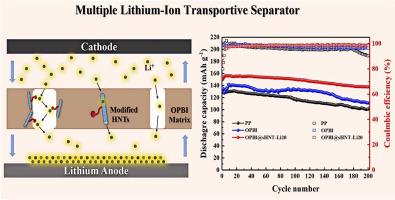Multi-channeled halloysite nanotube-blended polybenzimidazole separators for enhancing lithium-ion battery performance
IF 9
1区 工程技术
Q1 ENGINEERING, CHEMICAL
引用次数: 0
Abstract
The microscopic transport mode of lithium ions in the separator is crucial for solving the problem of irregular lithium dendrite growth, thereby enhancing the safety of battery operation, and it also has a positive impact on the electrochemical performance of the battery. Furthermore, the heat resistance of the separator is an important indicator for measuring the performance of the separator and the safety of battery usage. In this work, we have introduced sulfonated and lithiated halloysite nanotubes into a high-temperature-resistant OPBI matrix through an easily implementable NIPS, resulting in a high-temperature-resistant separator with multiple lithium-ion micro-transport morphologies. Lithium ions can shuttle through the halloysite nanotube pores, negatively charged sulfonate groups on the surface, and larger finger-like pores formed by NIPS within the separator, creating a high and uniform lithium-ion flux that prevents excessive localized ion flow leading to the aggressive growth of lithium dendrites. According to the characterization data, this separator exhibits relatively satisfactory performance, such as an ionic conductivity of 1.82 mS cm−1, a porosity of 82 %, an electrolyte uptake of 397 %, and no significant physical shrinkage at 200 °C. Additionally, the cells assembled using the OPBI@sHNT-Li20 separator delivers higher discharge capacity (164.92 mAh·g−1), more stable cycle, superior rate performance. So the OPBI@sHNT-Li separator is expected to play an active role in improving the safety and electrochemical performance of lithium-ion batteries.

用于提高锂离子电池性能的多通道霍洛石纳米管混合聚苯并咪唑隔膜
锂离子在隔膜中的微观传输模式对于解决锂枝晶的不规则生长问题至关重要,从而提高电池运行的安全性,同时也对电池的电化学性能产生积极影响。此外,隔膜的耐热性也是衡量隔膜性能和电池使用安全性的重要指标。在这项工作中,我们通过一种易于实现的 NIPS,将磺化和锂化的哈洛来石纳米管引入耐高温的 OPBI 基体中,从而得到了一种具有多种锂离子微传输形态的耐高温隔膜。锂离子可以穿梭于埃洛石纳米管孔隙、表面带负电荷的磺酸盐基团以及由 NIPS 在分离器内形成的较大的指状孔隙中,从而产生高且均匀的锂离子通量,防止过度的局部离子流导致锂枝晶的侵蚀生长。根据表征数据,这种隔膜的性能比较令人满意,例如离子电导率为 1.82 mS cm-1,孔隙率为 82%,电解质吸收率为 397%,在 200 °C 时没有明显的物理收缩。此外,使用 OPBI@sHNT-Li20 隔离层组装的电池具有更高的放电容量(164.92 mAh-g-1)、更稳定的循环和更优越的速率性能。因此,OPBI@sHNT-Li 隔膜有望在提高锂离子电池的安全性和电化学性能方面发挥积极作用。
本文章由计算机程序翻译,如有差异,请以英文原文为准。
求助全文
约1分钟内获得全文
求助全文
来源期刊

Journal of Membrane Science
工程技术-高分子科学
CiteScore
17.10
自引率
17.90%
发文量
1031
审稿时长
2.5 months
期刊介绍:
The Journal of Membrane Science is a publication that focuses on membrane systems and is aimed at academic and industrial chemists, chemical engineers, materials scientists, and membranologists. It publishes original research and reviews on various aspects of membrane transport, membrane formation/structure, fouling, module/process design, and processes/applications. The journal primarily focuses on the structure, function, and performance of non-biological membranes but also includes papers that relate to biological membranes. The Journal of Membrane Science publishes Full Text Papers, State-of-the-Art Reviews, Letters to the Editor, and Perspectives.
 求助内容:
求助内容: 应助结果提醒方式:
应助结果提醒方式:


